Global Business Environment: Remote Work Literature Review
VerifiedAdded on 2022/12/22
|7
|2443
|75
Report
AI Summary
This report is a mini literature review that examines the trends in the global business environment, specifically focusing on remote work. It analyzes the challenges associated with remote work, such as employee exclusion and the need for improved workplace integration. The review explores various strategies to enhance remote employee engagement, including structured conversations around shared content and the use of online games to foster teamwork and trust. It also discusses the benefits of remote work, such as increased productivity and work-life balance, while emphasizing the importance of creating a cohesive and trusting environment for remote teams. The report concludes that remote work is becoming a global phenomenon and highlights the need for companies to adapt and implement strategies that support remote employees.
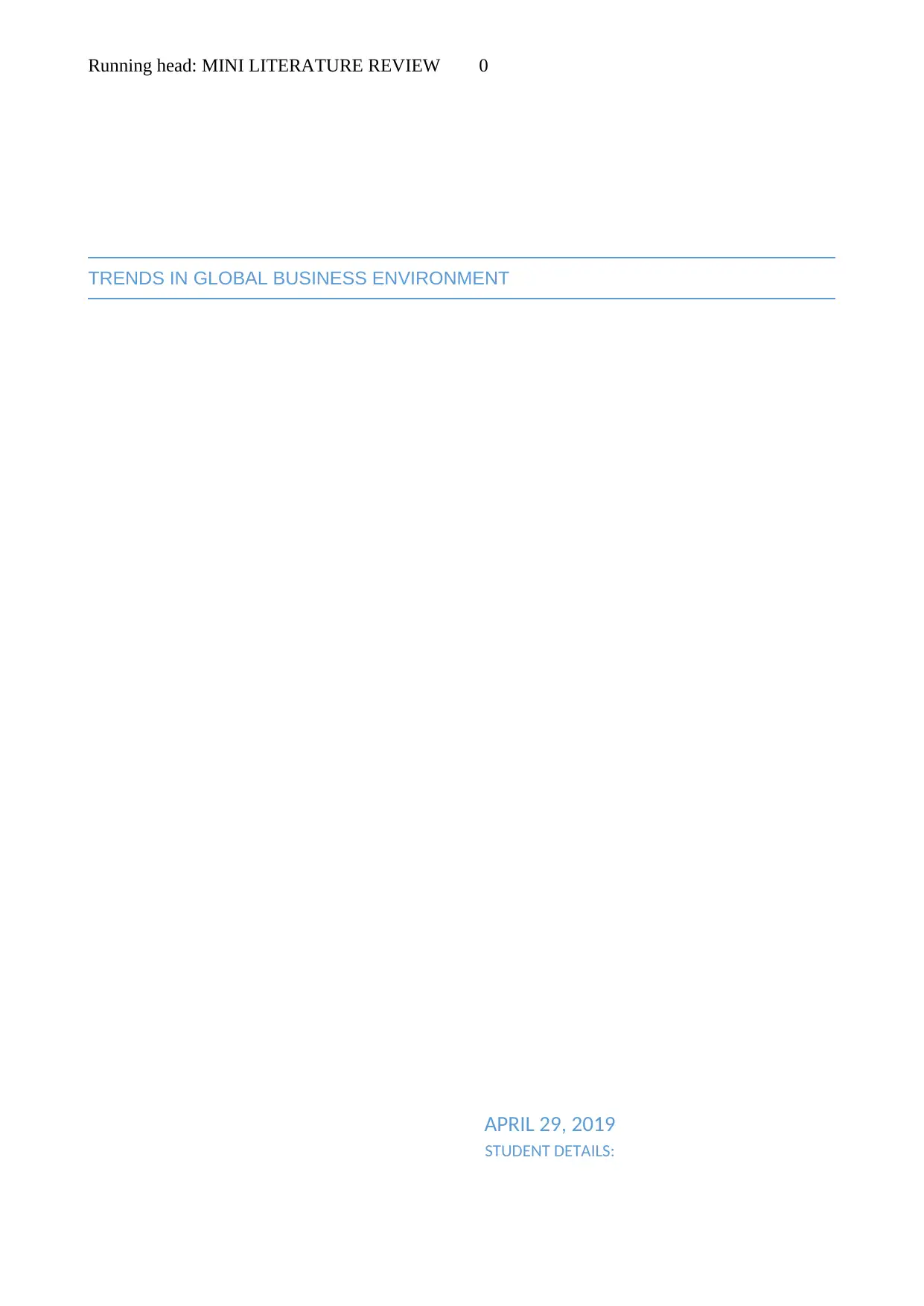
Running head: MINI LITERATURE REVIEW 0
TRENDS IN GLOBAL BUSINESS ENVIRONMENT
APRIL 29, 2019
STUDENT DETAILS:
TRENDS IN GLOBAL BUSINESS ENVIRONMENT
APRIL 29, 2019
STUDENT DETAILS:
Paraphrase This Document
Need a fresh take? Get an instant paraphrase of this document with our AI Paraphraser
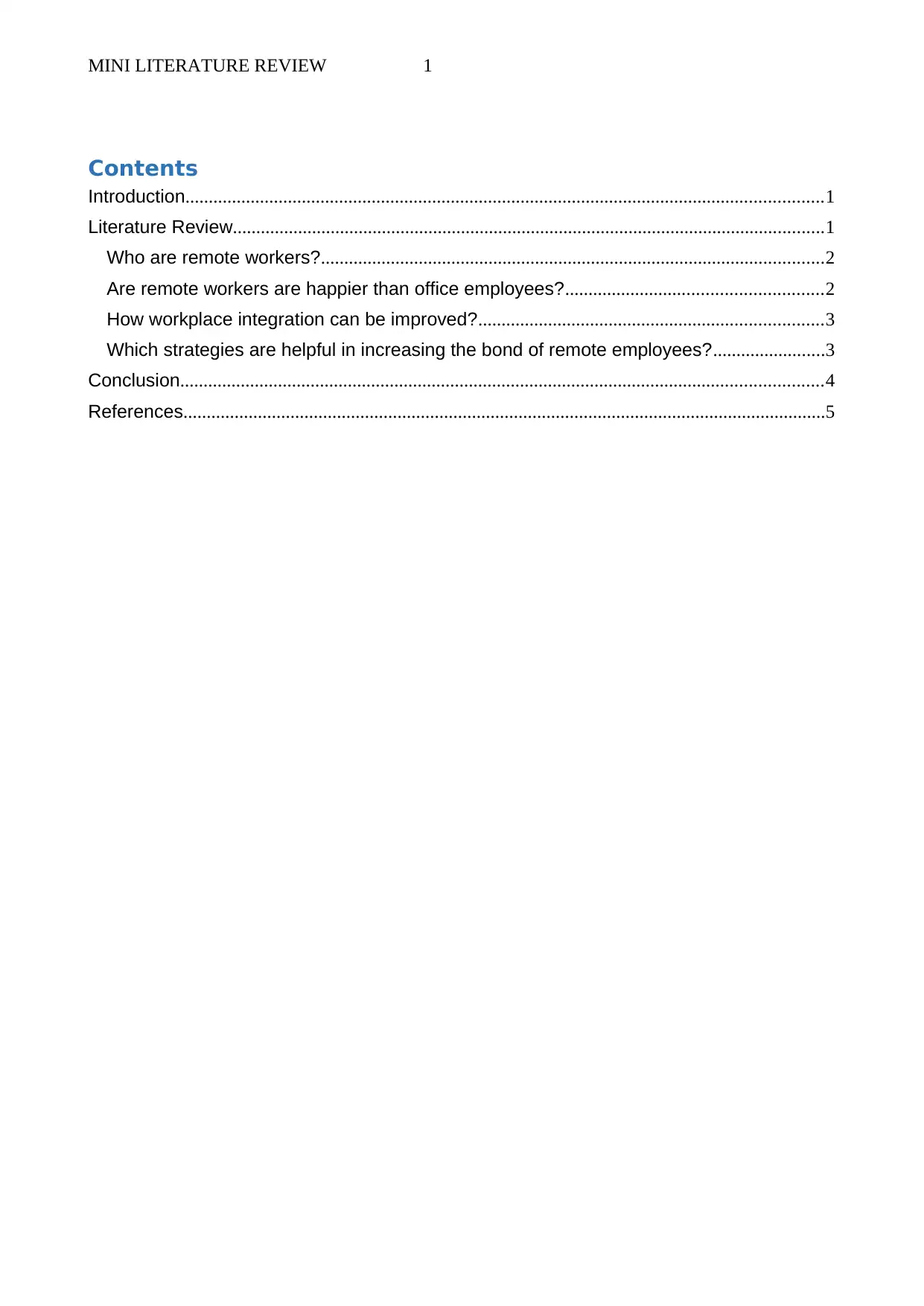
MINI LITERATURE REVIEW 1
Contents
Introduction.........................................................................................................................................1
Literature Review...............................................................................................................................1
Who are remote workers?............................................................................................................2
Are remote workers are happier than office employees?.......................................................2
How workplace integration can be improved?..........................................................................3
Which strategies are helpful in increasing the bond of remote employees?........................3
Conclusion..........................................................................................................................................4
References..........................................................................................................................................5
Contents
Introduction.........................................................................................................................................1
Literature Review...............................................................................................................................1
Who are remote workers?............................................................................................................2
Are remote workers are happier than office employees?.......................................................2
How workplace integration can be improved?..........................................................................3
Which strategies are helpful in increasing the bond of remote employees?........................3
Conclusion..........................................................................................................................................4
References..........................................................................................................................................5

MINI LITERATURE REVIEW 2
Introduction
The remote work is the ultimate working situation for the various workers. It may be very
complex for various managers. The managers of company may feel that they have no any
control in the situations or find that achieving the level of faith with the remote workforce
may be a bit of an issue (Lowmaster and T Intellectual Property, 2017). Yet, this is the way
of the opportunity of the workstation, and managers require adapting to create the situation
work for all the people included. In the following parts, the article “Ideas for helping remote
colleagues bond” is analysed and critically examined.
Literature Review
The remote workers are likely to feel excluded from the culture of corporation. The remote
employees report feelings, in a case they are not considered uniformly and often threat
that their co-workers are functioning against them (Epps and Close, 2017). When the
issues take place, nearly half of remote employees let this fester for the weeks or more. In
this context, after reading the article ideas for helping remote colleagues bond, following
four questions may arise-
Who are remote workers?
In recent days, the remote work is on the enlargement. So, the company doves in
information to search more in respect of the remote employees and to find how efficient
they are (Mulki, et. al, 2009). The remote work is the job, which can do from out of the
workstation. Sometimes, the remote work is also known as the Tele-working or
telecommuting. Various people consider the remote work as work from home (WFH).There
are numerous categories of remote work. There are certain individuals who are permitted
to do work remotely for one day or two days in a week. Further, there are some people,
who are permitted to be gone as regular as they would like. In fact, the remote work falls
under five levels of remote work, which can cover in different categories like based on
workplace, based on workplace with the option of work from home, remote workforce
within single period, global report workforce spread across various time period, and
completely allocated workforce with nomadic members of team (Dikova, et. al, 2016).
The remote workers are the workers who work out of the traditional offices. The remote
worker may do work from home, from coffee store, from café, or from the place that is not
the regular workplace; even though depending on the kinds of the jobs they do, they may
search themselves going at the workplace on the occasions (in a case where a hub of
company is physically near to the remote workers). The organisation may have the staff of
remote employees or a mixture of the office employees as well as remote workers. The
remote work cannot consider as work from office. Additionally, the remote workers are not
supposed to do work from workplace. Remote work is considered as working from any
location in the world wherever the workers are happy and most creative, irrespective of the
physical proximity to the workplace or a colleague is a reality for more than forty percent of
the team (Humphreys, et. al, 2017).
Are remote workers are happier than office employees?
Introduction
The remote work is the ultimate working situation for the various workers. It may be very
complex for various managers. The managers of company may feel that they have no any
control in the situations or find that achieving the level of faith with the remote workforce
may be a bit of an issue (Lowmaster and T Intellectual Property, 2017). Yet, this is the way
of the opportunity of the workstation, and managers require adapting to create the situation
work for all the people included. In the following parts, the article “Ideas for helping remote
colleagues bond” is analysed and critically examined.
Literature Review
The remote workers are likely to feel excluded from the culture of corporation. The remote
employees report feelings, in a case they are not considered uniformly and often threat
that their co-workers are functioning against them (Epps and Close, 2017). When the
issues take place, nearly half of remote employees let this fester for the weeks or more. In
this context, after reading the article ideas for helping remote colleagues bond, following
four questions may arise-
Who are remote workers?
In recent days, the remote work is on the enlargement. So, the company doves in
information to search more in respect of the remote employees and to find how efficient
they are (Mulki, et. al, 2009). The remote work is the job, which can do from out of the
workstation. Sometimes, the remote work is also known as the Tele-working or
telecommuting. Various people consider the remote work as work from home (WFH).There
are numerous categories of remote work. There are certain individuals who are permitted
to do work remotely for one day or two days in a week. Further, there are some people,
who are permitted to be gone as regular as they would like. In fact, the remote work falls
under five levels of remote work, which can cover in different categories like based on
workplace, based on workplace with the option of work from home, remote workforce
within single period, global report workforce spread across various time period, and
completely allocated workforce with nomadic members of team (Dikova, et. al, 2016).
The remote workers are the workers who work out of the traditional offices. The remote
worker may do work from home, from coffee store, from café, or from the place that is not
the regular workplace; even though depending on the kinds of the jobs they do, they may
search themselves going at the workplace on the occasions (in a case where a hub of
company is physically near to the remote workers). The organisation may have the staff of
remote employees or a mixture of the office employees as well as remote workers. The
remote work cannot consider as work from office. Additionally, the remote workers are not
supposed to do work from workplace. Remote work is considered as working from any
location in the world wherever the workers are happy and most creative, irrespective of the
physical proximity to the workplace or a colleague is a reality for more than forty percent of
the team (Humphreys, et. al, 2017).
Are remote workers are happier than office employees?
⊘ This is a preview!⊘
Do you want full access?
Subscribe today to unlock all pages.

Trusted by 1+ million students worldwide
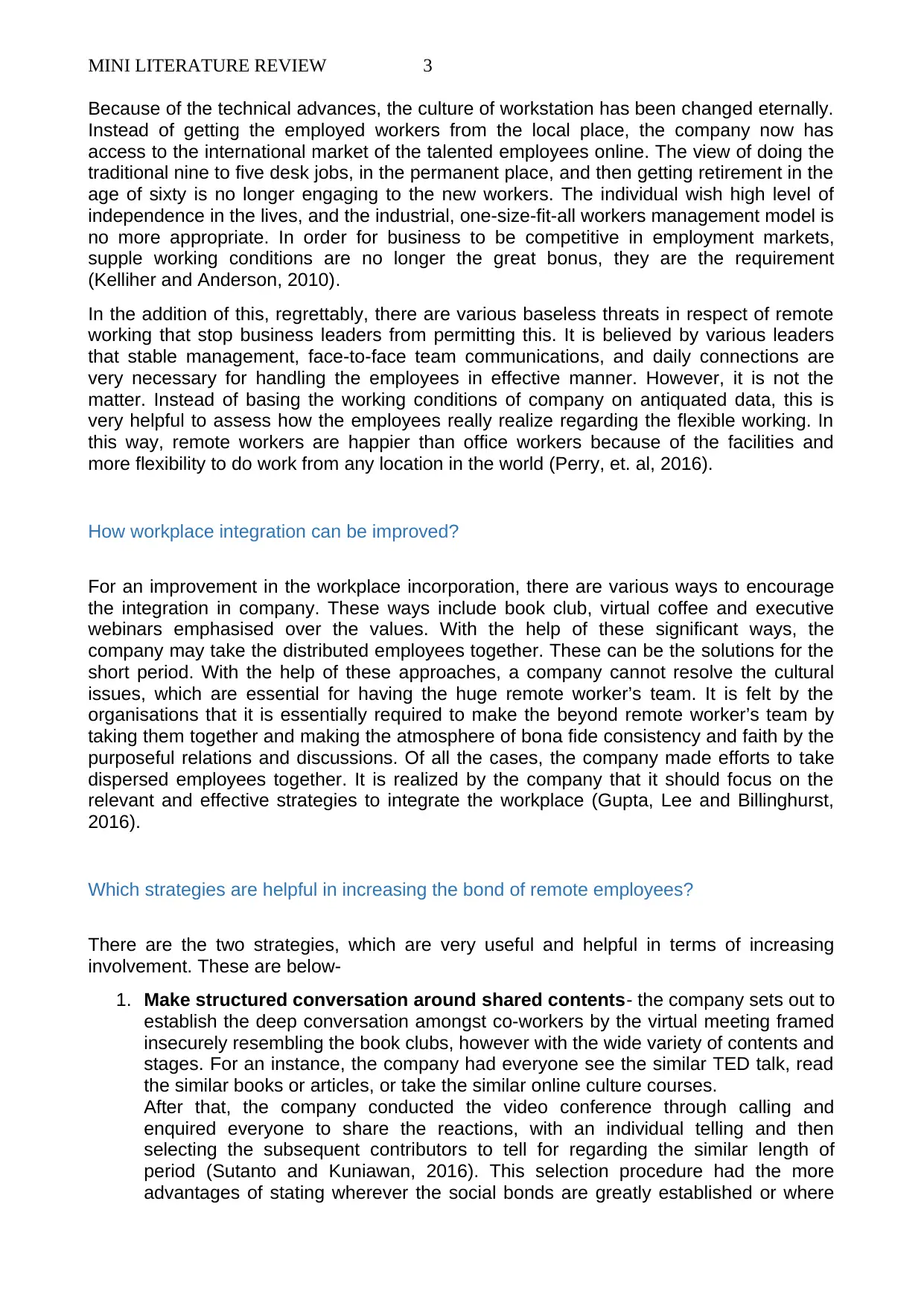
MINI LITERATURE REVIEW 3
Because of the technical advances, the culture of workstation has been changed eternally.
Instead of getting the employed workers from the local place, the company now has
access to the international market of the talented employees online. The view of doing the
traditional nine to five desk jobs, in the permanent place, and then getting retirement in the
age of sixty is no longer engaging to the new workers. The individual wish high level of
independence in the lives, and the industrial, one-size-fit-all workers management model is
no more appropriate. In order for business to be competitive in employment markets,
supple working conditions are no longer the great bonus, they are the requirement
(Kelliher and Anderson, 2010).
In the addition of this, regrettably, there are various baseless threats in respect of remote
working that stop business leaders from permitting this. It is believed by various leaders
that stable management, face-to-face team communications, and daily connections are
very necessary for handling the employees in effective manner. However, it is not the
matter. Instead of basing the working conditions of company on antiquated data, this is
very helpful to assess how the employees really realize regarding the flexible working. In
this way, remote workers are happier than office workers because of the facilities and
more flexibility to do work from any location in the world (Perry, et. al, 2016).
How workplace integration can be improved?
For an improvement in the workplace incorporation, there are various ways to encourage
the integration in company. These ways include book club, virtual coffee and executive
webinars emphasised over the values. With the help of these significant ways, the
company may take the distributed employees together. These can be the solutions for the
short period. With the help of these approaches, a company cannot resolve the cultural
issues, which are essential for having the huge remote worker’s team. It is felt by the
organisations that it is essentially required to make the beyond remote worker’s team by
taking them together and making the atmosphere of bona fide consistency and faith by the
purposeful relations and discussions. Of all the cases, the company made efforts to take
dispersed employees together. It is realized by the company that it should focus on the
relevant and effective strategies to integrate the workplace (Gupta, Lee and Billinghurst,
2016).
Which strategies are helpful in increasing the bond of remote employees?
There are the two strategies, which are very useful and helpful in terms of increasing
involvement. These are below-
1. Make structured conversation around shared contents- the company sets out to
establish the deep conversation amongst co-workers by the virtual meeting framed
insecurely resembling the book clubs, however with the wide variety of contents and
stages. For an instance, the company had everyone see the similar TED talk, read
the similar books or articles, or take the similar online culture courses.
After that, the company conducted the video conference through calling and
enquired everyone to share the reactions, with an individual telling and then
selecting the subsequent contributors to tell for regarding the similar length of
period (Sutanto and Kuniawan, 2016). This selection procedure had the more
advantages of stating wherever the social bonds are greatly established or where
Because of the technical advances, the culture of workstation has been changed eternally.
Instead of getting the employed workers from the local place, the company now has
access to the international market of the talented employees online. The view of doing the
traditional nine to five desk jobs, in the permanent place, and then getting retirement in the
age of sixty is no longer engaging to the new workers. The individual wish high level of
independence in the lives, and the industrial, one-size-fit-all workers management model is
no more appropriate. In order for business to be competitive in employment markets,
supple working conditions are no longer the great bonus, they are the requirement
(Kelliher and Anderson, 2010).
In the addition of this, regrettably, there are various baseless threats in respect of remote
working that stop business leaders from permitting this. It is believed by various leaders
that stable management, face-to-face team communications, and daily connections are
very necessary for handling the employees in effective manner. However, it is not the
matter. Instead of basing the working conditions of company on antiquated data, this is
very helpful to assess how the employees really realize regarding the flexible working. In
this way, remote workers are happier than office workers because of the facilities and
more flexibility to do work from any location in the world (Perry, et. al, 2016).
How workplace integration can be improved?
For an improvement in the workplace incorporation, there are various ways to encourage
the integration in company. These ways include book club, virtual coffee and executive
webinars emphasised over the values. With the help of these significant ways, the
company may take the distributed employees together. These can be the solutions for the
short period. With the help of these approaches, a company cannot resolve the cultural
issues, which are essential for having the huge remote worker’s team. It is felt by the
organisations that it is essentially required to make the beyond remote worker’s team by
taking them together and making the atmosphere of bona fide consistency and faith by the
purposeful relations and discussions. Of all the cases, the company made efforts to take
dispersed employees together. It is realized by the company that it should focus on the
relevant and effective strategies to integrate the workplace (Gupta, Lee and Billinghurst,
2016).
Which strategies are helpful in increasing the bond of remote employees?
There are the two strategies, which are very useful and helpful in terms of increasing
involvement. These are below-
1. Make structured conversation around shared contents- the company sets out to
establish the deep conversation amongst co-workers by the virtual meeting framed
insecurely resembling the book clubs, however with the wide variety of contents and
stages. For an instance, the company had everyone see the similar TED talk, read
the similar books or articles, or take the similar online culture courses.
After that, the company conducted the video conference through calling and
enquired everyone to share the reactions, with an individual telling and then
selecting the subsequent contributors to tell for regarding the similar length of
period (Sutanto and Kuniawan, 2016). This selection procedure had the more
advantages of stating wherever the social bonds are greatly established or where
Paraphrase This Document
Need a fresh take? Get an instant paraphrase of this document with our AI Paraphraser
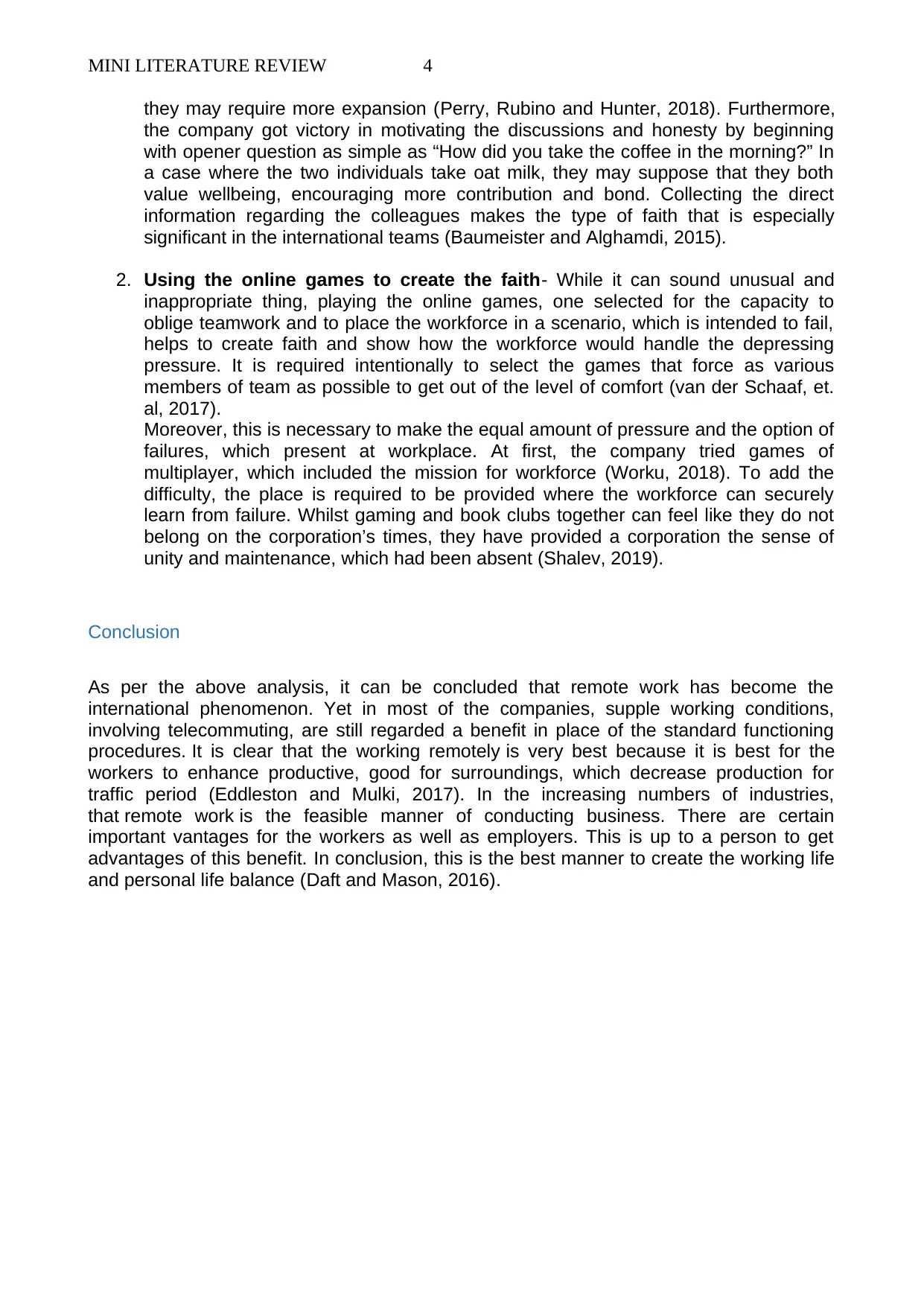
MINI LITERATURE REVIEW 4
they may require more expansion (Perry, Rubino and Hunter, 2018). Furthermore,
the company got victory in motivating the discussions and honesty by beginning
with opener question as simple as “How did you take the coffee in the morning?” In
a case where the two individuals take oat milk, they may suppose that they both
value wellbeing, encouraging more contribution and bond. Collecting the direct
information regarding the colleagues makes the type of faith that is especially
significant in the international teams (Baumeister and Alghamdi, 2015).
2. Using the online games to create the faith- While it can sound unusual and
inappropriate thing, playing the online games, one selected for the capacity to
oblige teamwork and to place the workforce in a scenario, which is intended to fail,
helps to create faith and show how the workforce would handle the depressing
pressure. It is required intentionally to select the games that force as various
members of team as possible to get out of the level of comfort (van der Schaaf, et.
al, 2017).
Moreover, this is necessary to make the equal amount of pressure and the option of
failures, which present at workplace. At first, the company tried games of
multiplayer, which included the mission for workforce (Worku, 2018). To add the
difficulty, the place is required to be provided where the workforce can securely
learn from failure. Whilst gaming and book clubs together can feel like they do not
belong on the corporation’s times, they have provided a corporation the sense of
unity and maintenance, which had been absent (Shalev, 2019).
Conclusion
As per the above analysis, it can be concluded that remote work has become the
international phenomenon. Yet in most of the companies, supple working conditions,
involving telecommuting, are still regarded a benefit in place of the standard functioning
procedures. It is clear that the working remotely is very best because it is best for the
workers to enhance productive, good for surroundings, which decrease production for
traffic period (Eddleston and Mulki, 2017). In the increasing numbers of industries,
that remote work is the feasible manner of conducting business. There are certain
important vantages for the workers as well as employers. This is up to a person to get
advantages of this benefit. In conclusion, this is the best manner to create the working life
and personal life balance (Daft and Mason, 2016).
they may require more expansion (Perry, Rubino and Hunter, 2018). Furthermore,
the company got victory in motivating the discussions and honesty by beginning
with opener question as simple as “How did you take the coffee in the morning?” In
a case where the two individuals take oat milk, they may suppose that they both
value wellbeing, encouraging more contribution and bond. Collecting the direct
information regarding the colleagues makes the type of faith that is especially
significant in the international teams (Baumeister and Alghamdi, 2015).
2. Using the online games to create the faith- While it can sound unusual and
inappropriate thing, playing the online games, one selected for the capacity to
oblige teamwork and to place the workforce in a scenario, which is intended to fail,
helps to create faith and show how the workforce would handle the depressing
pressure. It is required intentionally to select the games that force as various
members of team as possible to get out of the level of comfort (van der Schaaf, et.
al, 2017).
Moreover, this is necessary to make the equal amount of pressure and the option of
failures, which present at workplace. At first, the company tried games of
multiplayer, which included the mission for workforce (Worku, 2018). To add the
difficulty, the place is required to be provided where the workforce can securely
learn from failure. Whilst gaming and book clubs together can feel like they do not
belong on the corporation’s times, they have provided a corporation the sense of
unity and maintenance, which had been absent (Shalev, 2019).
Conclusion
As per the above analysis, it can be concluded that remote work has become the
international phenomenon. Yet in most of the companies, supple working conditions,
involving telecommuting, are still regarded a benefit in place of the standard functioning
procedures. It is clear that the working remotely is very best because it is best for the
workers to enhance productive, good for surroundings, which decrease production for
traffic period (Eddleston and Mulki, 2017). In the increasing numbers of industries,
that remote work is the feasible manner of conducting business. There are certain
important vantages for the workers as well as employers. This is up to a person to get
advantages of this benefit. In conclusion, this is the best manner to create the working life
and personal life balance (Daft and Mason, 2016).
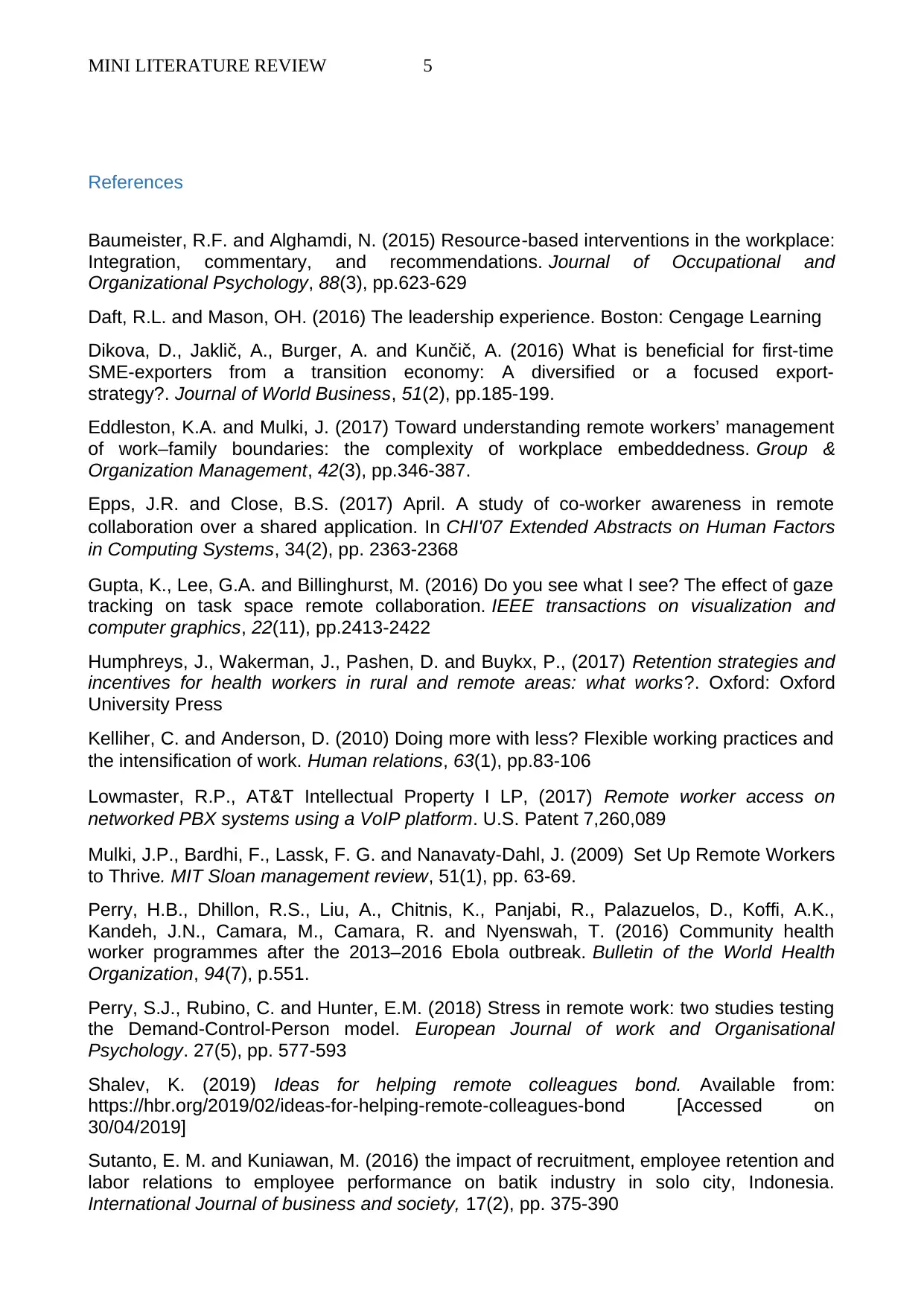
MINI LITERATURE REVIEW 5
References
Baumeister, R.F. and Alghamdi, N. (2015) Resource‐based interventions in the workplace:
Integration, commentary, and recommendations. Journal of Occupational and
Organizational Psychology, 88(3), pp.623-629
Daft, R.L. and Mason, OH. (2016) The leadership experience. Boston: Cengage Learning
Dikova, D., Jaklič, A., Burger, A. and Kunčič, A. (2016) What is beneficial for first-time
SME-exporters from a transition economy: A diversified or a focused export-
strategy?. Journal of World Business, 51(2), pp.185-199.
Eddleston, K.A. and Mulki, J. (2017) Toward understanding remote workers’ management
of work–family boundaries: the complexity of workplace embeddedness. Group &
Organization Management, 42(3), pp.346-387.
Epps, J.R. and Close, B.S. (2017) April. A study of co-worker awareness in remote
collaboration over a shared application. In CHI'07 Extended Abstracts on Human Factors
in Computing Systems, 34(2), pp. 2363-2368
Gupta, K., Lee, G.A. and Billinghurst, M. (2016) Do you see what I see? The effect of gaze
tracking on task space remote collaboration. IEEE transactions on visualization and
computer graphics, 22(11), pp.2413-2422
Humphreys, J., Wakerman, J., Pashen, D. and Buykx, P., (2017) Retention strategies and
incentives for health workers in rural and remote areas: what works?. Oxford: Oxford
University Press
Kelliher, C. and Anderson, D. (2010) Doing more with less? Flexible working practices and
the intensification of work. Human relations, 63(1), pp.83-106
Lowmaster, R.P., AT&T Intellectual Property I LP, (2017) Remote worker access on
networked PBX systems using a VoIP platform. U.S. Patent 7,260,089
Mulki, J.P., Bardhi, F., Lassk, F. G. and Nanavaty-Dahl, J. (2009) Set Up Remote Workers
to Thrive. MIT Sloan management review, 51(1), pp. 63-69.
Perry, H.B., Dhillon, R.S., Liu, A., Chitnis, K., Panjabi, R., Palazuelos, D., Koffi, A.K.,
Kandeh, J.N., Camara, M., Camara, R. and Nyenswah, T. (2016) Community health
worker programmes after the 2013–2016 Ebola outbreak. Bulletin of the World Health
Organization, 94(7), p.551.
Perry, S.J., Rubino, C. and Hunter, E.M. (2018) Stress in remote work: two studies testing
the Demand-Control-Person model. European Journal of work and Organisational
Psychology. 27(5), pp. 577-593
Shalev, K. (2019) Ideas for helping remote colleagues bond. Available from:
https://hbr.org/2019/02/ideas-for-helping-remote-colleagues-bond [Accessed on
30/04/2019]
Sutanto, E. M. and Kuniawan, M. (2016) the impact of recruitment, employee retention and
labor relations to employee performance on batik industry in solo city, Indonesia.
International Journal of business and society, 17(2), pp. 375-390
References
Baumeister, R.F. and Alghamdi, N. (2015) Resource‐based interventions in the workplace:
Integration, commentary, and recommendations. Journal of Occupational and
Organizational Psychology, 88(3), pp.623-629
Daft, R.L. and Mason, OH. (2016) The leadership experience. Boston: Cengage Learning
Dikova, D., Jaklič, A., Burger, A. and Kunčič, A. (2016) What is beneficial for first-time
SME-exporters from a transition economy: A diversified or a focused export-
strategy?. Journal of World Business, 51(2), pp.185-199.
Eddleston, K.A. and Mulki, J. (2017) Toward understanding remote workers’ management
of work–family boundaries: the complexity of workplace embeddedness. Group &
Organization Management, 42(3), pp.346-387.
Epps, J.R. and Close, B.S. (2017) April. A study of co-worker awareness in remote
collaboration over a shared application. In CHI'07 Extended Abstracts on Human Factors
in Computing Systems, 34(2), pp. 2363-2368
Gupta, K., Lee, G.A. and Billinghurst, M. (2016) Do you see what I see? The effect of gaze
tracking on task space remote collaboration. IEEE transactions on visualization and
computer graphics, 22(11), pp.2413-2422
Humphreys, J., Wakerman, J., Pashen, D. and Buykx, P., (2017) Retention strategies and
incentives for health workers in rural and remote areas: what works?. Oxford: Oxford
University Press
Kelliher, C. and Anderson, D. (2010) Doing more with less? Flexible working practices and
the intensification of work. Human relations, 63(1), pp.83-106
Lowmaster, R.P., AT&T Intellectual Property I LP, (2017) Remote worker access on
networked PBX systems using a VoIP platform. U.S. Patent 7,260,089
Mulki, J.P., Bardhi, F., Lassk, F. G. and Nanavaty-Dahl, J. (2009) Set Up Remote Workers
to Thrive. MIT Sloan management review, 51(1), pp. 63-69.
Perry, H.B., Dhillon, R.S., Liu, A., Chitnis, K., Panjabi, R., Palazuelos, D., Koffi, A.K.,
Kandeh, J.N., Camara, M., Camara, R. and Nyenswah, T. (2016) Community health
worker programmes after the 2013–2016 Ebola outbreak. Bulletin of the World Health
Organization, 94(7), p.551.
Perry, S.J., Rubino, C. and Hunter, E.M. (2018) Stress in remote work: two studies testing
the Demand-Control-Person model. European Journal of work and Organisational
Psychology. 27(5), pp. 577-593
Shalev, K. (2019) Ideas for helping remote colleagues bond. Available from:
https://hbr.org/2019/02/ideas-for-helping-remote-colleagues-bond [Accessed on
30/04/2019]
Sutanto, E. M. and Kuniawan, M. (2016) the impact of recruitment, employee retention and
labor relations to employee performance on batik industry in solo city, Indonesia.
International Journal of business and society, 17(2), pp. 375-390
⊘ This is a preview!⊘
Do you want full access?
Subscribe today to unlock all pages.

Trusted by 1+ million students worldwide
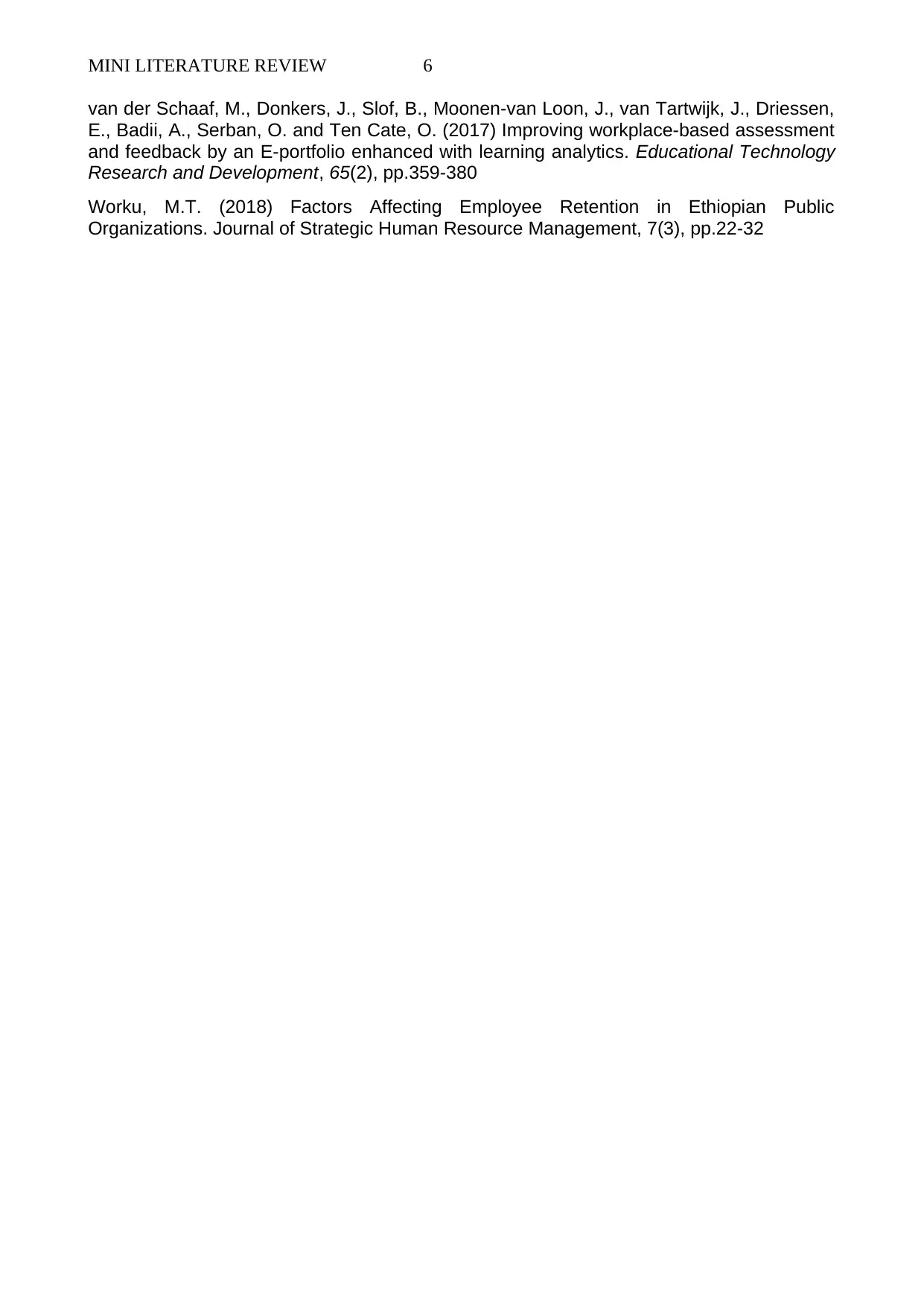
MINI LITERATURE REVIEW 6
van der Schaaf, M., Donkers, J., Slof, B., Moonen-van Loon, J., van Tartwijk, J., Driessen,
E., Badii, A., Serban, O. and Ten Cate, O. (2017) Improving workplace-based assessment
and feedback by an E-portfolio enhanced with learning analytics. Educational Technology
Research and Development, 65(2), pp.359-380
Worku, M.T. (2018) Factors Affecting Employee Retention in Ethiopian Public
Organizations. Journal of Strategic Human Resource Management, 7(3), pp.22-32
van der Schaaf, M., Donkers, J., Slof, B., Moonen-van Loon, J., van Tartwijk, J., Driessen,
E., Badii, A., Serban, O. and Ten Cate, O. (2017) Improving workplace-based assessment
and feedback by an E-portfolio enhanced with learning analytics. Educational Technology
Research and Development, 65(2), pp.359-380
Worku, M.T. (2018) Factors Affecting Employee Retention in Ethiopian Public
Organizations. Journal of Strategic Human Resource Management, 7(3), pp.22-32
1 out of 7
Related Documents
Your All-in-One AI-Powered Toolkit for Academic Success.
+13062052269
info@desklib.com
Available 24*7 on WhatsApp / Email
![[object Object]](/_next/static/media/star-bottom.7253800d.svg)
Unlock your academic potential
Copyright © 2020–2025 A2Z Services. All Rights Reserved. Developed and managed by ZUCOL.




